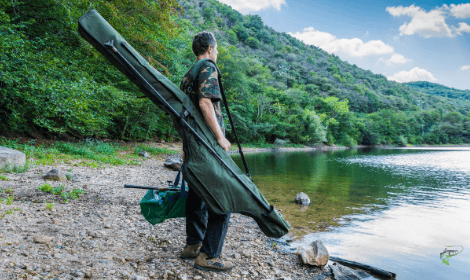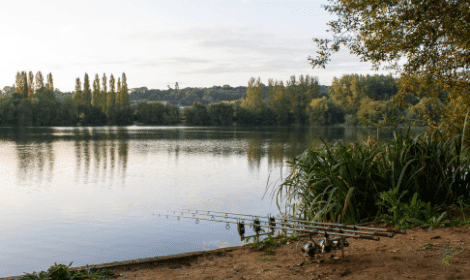
Margin fishing for carp is typically underutilized by many carp anglers who prefer fishing swims, casting long distance in search of carp, while ignoring the shallow waters by their feet, where carp will frequent. This post will take a detailed look into margin fishing.
What Is Margin Fishing?
Margin fishing, simply speaking, is fishing very close to the bank instead of casting out to the middle of the body of water or long-distance casting to the opposite shoreline or island.
Margin fishing is a perfect method for short-session anglers with a limited amount of fishing time, and it’s also an incredibly useful and overlooked method of carp fishing.
Why Should You fish the Margins?
As mentioned earlier, the margins or banks that include spots where many anglers cast from but don’t fish directly are beneficial to fish for many reasons. One reason is that these areas are typically underfished, with anglers casting away from them, but there are even better reasons.
One reason is in the spring, and early summer months, as the water starts to get warm, the carp will be cruising around the banks in search of food. In many cases, this allows you to see the fish, and sight fishing is common with this fishing style, giving you a front-row view of the carp eating your bait.
Stalking carp or walking the bank and sight fishing them also gives you a mental roadmap of the waters you fish, allowing you to discover fish-holding areas by simply seeing carp on the spots regularly.
As mentioned briefly above, margin fishing is great for anglers with tight time constraints. You can stalk the edge of the water looking for single fish and present them a bait, this cuts down on the waiting time with other types of fishing, making your time on the water incredibly efficient, and many times more productive than the standard ways of carp fishing.
This type of fishing is the hand to hand combat of carp angling, and it’s a thrill that traditional methods can’t rival when it comes to excitement and adrenaline and this is one of the main reasons some anglers love this method so much.
How to Find Fish in the Margins?

Something I see many anglers do when arriving to a new body of water, is to instantly set up and start casting to good looking spots. This tactic is not the best way to approach a new body of water, especially for margin fishing.
Start stalking the shorelines and search for signs of fish. These signs could be rolling or fishing coming to the surface, or clouds of silt from fish you may have just spooked from the shallows.
A good pair of polarized glasses can help you to see the actual carp in the water if they are closer to shore and the water is calm and clear. Polarized glasses are a must for this type of fishing; as mentioned earlier, most of the fish you will be catching will be from sighting them in the shallows.
Scouting is imperative and the most important and core part of any margin fishing session if you want to be successful. After stalking and scouting a body of water a couple of times, you will notice areas that consistently hold fish. In future sessions, you can narrow down your fishing spots to be as efficient and productive as possible.
Baiting and Margin Fishing
If you are struggling to sight carp near the banks, key in on fish-holding spots like rushes, lily pads, or overhanging trees or shrubbery. These spots will likely hold fish throughout the day, and multiple fish will use and leave these areas daily.
When baiting around these fish-holding spots, it’s crucial that you use minimal amounts of bait. I typically use a corn and pellet mix and only throw out a few handfuls of bait; we are looking for quick bites while margin fishing and are not trying to hold fish in an area for extended periods of time as one would with conventional carp fishing.
Best Weather For Margin Fishing

Margin fishing via stalking is the best when water conditions are calm and clear, simply because it’s easier to spot the carp in the shallows. Sunshine is also great, but not necessary, and cloudy overcast days can be particularly effective as the fish tend to be in the shallows more frequently at times in overcast conditions, as the cloud cover gives them a sense of security, and in many cases, the overcast sky indicates a low front and high feeding activity.
If there was wind that has been blowing from the same direction for a few days, you might be able to have some great success on the water. Fishing the windblown side of the lake, or where the waves have repeatedly been beating onto the same shoreline, means that food has been washing up on that shore.
This wind and wave action creates a carp buffet of food, and the carp follow, making for some fast and furious angling with multiple catches while margin fishing not uncommon. For this to be successful, you as a fisherman need to keep a close eye on the weather and wind direction on a daily basis.
If the wind switches direction the day you go out to fish, you may be inclined to fish the windblown side of the lake, but in reality, the majority of the carp will still be on the side where the wind pushed food up to a different bank for multiple days prior to your session.
You can also successfully margin fish in rainy conditions as well, but this is definitely not easy to fish if you plan on sight fishing, and you should stick to spots where you already know carp regularly frequent for a chance to catch some, as spotting fish can be very difficult.
Margin Fishing Tips
In this section, I’ll give you some tips if you’re new to the margin fishing technique; these tips will undoubtedly help you in your carp stalking sessions.
1. Wash out spots
If you are fishing a fairly pressured body of water that gets a good amount of carp angling traffic, this is a great tactic. You will be margin fishing where other carp anglers stand and cast out on a regular basis; during these other anglers’ sessions, they will most likely spill bait into the water next to the bank while spodding and baiting.
Carp will take advantage of this small amount of spillage, and you should take advantage of it too. The key to this is to bait very lightly when you fish these spots, as the carp are accustomed to there being very little actual bait, and better yet, it would be a great idea to pre-soak your bait, so it appears as they have been laying in the water for a long amount of time because these carp are eating the free offerings typically when fisherman aren’t present to spook them.
2. Make a Trail of Bait
A good tactic to try is to lay a light trail of bait up the bank. We can imagine the carp patrolling the bank in search of food, cruising up or down the shallow water and any reeds or structure along the way. Going 5 to 10 meters from the exact spot you intend to fish and toss out some bait leading up to your hook bait, this trail will lead them directly to you.
3. Be Stealthy
When margin fishing, you are the equivalent to that of a carp catching sniper; this means you need to approach the banks as quietly as possible.
Avoid stamping feet when stalking or lobbing tons of bait into the water, we want subtle movements here, and moving arms or any type of fast movement can and will spook carp in the shallows.
You are a hunter, and when you reach a spot and can actually see a fish by sight, you need to deliver your bait as precisely and quietly as humanly possible.
Margin fishing is a good opportunity to freeline your bait. Freelining is having nothing but a hook and a piece of bait attached to your line; when a fish is sighted, you can drop this bait into the water as discreetly as one can, and it will appear more natural to a carp due to the minimal disturbance.
4. Get In the Water
If allowed on the body of water your fishing, get a pair of waders and get into the water. Better yet, if it’s frowned upon, offer to do some clean-up and tidy up the margins if it’s club water.
You will get a detailed insight that you may not get from shore, and in the meantime, you can actually clean up some margins that you intend to fish. Find spots and then cleaning up these spots is a win-win situation.
5. Rotate your Spots
Rotating to your spots throughout an afternoon is an important consideration. I would spend no more than one hour at the most at any given spot before moving on.
This tactic allows you to cover more water and create better odds at contacting more potential catches, and it will also give you insight on any preferred areas the carp are using on a given day.
6. Find Clear Spots
Depending on the lake, you may find that the margins have a substantial amount of debris, such as dead leaves and branches, and twigs.
However, there should be areas clean of debris, and this can be a great indicator that fish are regularly feeding in these spots and keeping the bottom free of this debris, making it a great potential margin spot.
Once these spots are found, it’s also a good idea to throw a handful of bait on them even before you leave for the day. This keeps the fish coming back and will allow you to catch fish on these clearings regularly.
That’s All!
Margin fishing for carp, as mentioned earlier, is often overlooked by many carp anglers, or they simply don’t margin fish very often. If you intend on margin fishing, this is a major bonus, as your local carp populations may be very easy to catch using this method.

